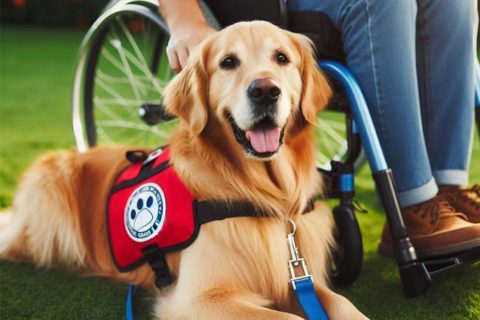When it comes to the term “Psychiatric Service Dog (PSD),” it refers to the service dogs who are trained to help people with mental disorders such as obsessive compulsive disorder, post-traumatic stress disorder, schizophrenia, etc. fight against their illness to carry out their daily activities normally.

A well-trained PSD has the ability to see symptoms in someone caused by a mental illness. Further, he can try to comfort their owners when they get anxious or are in distress. Of course, a psychiatric service dog could be necessary for those of you who have some emotional health problems.
But how do you get a psychiatric service dog? And what requirements should you meet? Thankfully! We’ll show you the simple guide to getting one and what a psychiatric service dog can do to help people with mental disorders. Let’s check them out!
How Can a Psychiatric Service Dog Help People with Mental Problems?
Actually, any dog breed may have the potential to be a service dog, but there are a few things to consider before determining whether or not a dog qualifies for psychiatric training, including whether the dog doesn’t exhibit aggressive behavior or is calm in public.
Not only being trained to alert to seizures and other medical conditions, a psychiatric service dog could also be trained to sense the changes in an individual’s body called the “Alert” command when they begin to have a panic attack, anxiety attack, flashbacks, or other psychiatric conditions.
When the time came, a psychiatric service dog would paw at the leg of his handler. In this case, he can give a discrete signal to their service dogs to command their dogs to paw their legs, so he can pass through the situation with the excuse that the dog needs to defecate.
To make it easier for you to identify what a psychiatric service dog will do for you, we’ll show you some examples of his actions for people with mental disorders. Here they are:
- Provide body contact or tactile stimulation to reduce anxiety or panic attacks.
- Lick, paw, or nudge to bring the handlers back to a state of awareness or reality for post-traumatic stress disorder (PTSD).
- Take medications or remind people to take them.
- Wake up the handlers from nightmares.
- Block people from approaching the handlers to create a safe space for them.
- Remind people to perform other self-care activities.
- Lead the handler out of a high-stress situation.
- Prevent the handler from being too stationary for long periods of time.
- Protect and make the handlers secure.
- Help the handler with a daily routine.
Furthermore, a psychiatric service dog may also take a ringing telephone and alert the handlers to doorbells or when someone comes. He can also provide emotional support and companionship to their handlers.
Getting a Psychiatric Service Dog: Here’s a Step-by-Step
As long as you understand the steps, getting a psychiatric dog is quite simple. Keep in mind that it’s not haphazard to get one. It means that there will be several medical steps that you must take regarding your mental condition.
There’s a series of steps you’ll have to take before finally getting a psychiatric service dog (PSD), including:
Step 1: Get a medical diagnosis first
Speaking with a psychiatrist to discuss your mental disorder is the first step you should take. However, the psychological experts can determine whether you have a diagnosis of mental illness.
To be eligible for a psychiatric service dog, you should be legally disabled under the Americans with Disabilities Act (ADA) and provide appropriate medical documentation. ADA also reveals that a service dog must be able to help the handlers with tasks that can assist them in having a better quality of life.
The following are the types of mental disorders that will qualify for a psychiatric service dog:
- Anxiety Disorder
- Bipolar Disorder
- Depression
- Panic Attacks
- Obsessive-Compulsive Disorder (OCD)
- Post-Traumatic Stress Disorder (PTSD)
- Schizophrenia
- Agoraphobia
Once you undergo a mental check, the psychiatrist will give you a letter that specifies the need for a PSD.
Step 2: Finding a psychiatric service dog (PSD)
After receiving a PSD letter, you can now try to look for a PSD. There are some options you can take to get a PSD, including:
- Buying a trained PSD: This is the fastest way to get a PSD. You can purchase one from a trusted organization that specifically trains PSDs. Considering the ease of getting a PSD, it is often the most expensive way to go.
- Adopting a PSD: If you don’t want to spend much money, you can take one from a local animal shelter. The dogs from the community would be cheaper, although their ability to help people with mental disorders may not be any more competent than buying from an organization.
- Enroll in a PSD training program: Even though ADA doesn’t require PSDs to pass through a training program, it’s also important, especially if you want to learn how to train your own dog to be a service dog.
- Self-training: The cheapest option is to train a dog yourself. Instead of enrolling in a training program, you can also take advantage of an online PSD training program. Even though this way would be a little bit complicated, it’s a great option for you to build a bond with your dog and take the perfect pace for you and your dog.
To get the best psychiatric service dog, you need to consider the breed. That said, there are some breeds that may be better suited for a PSD. But it depends on the situation and an individual’s needs.
Here are some popular breeds that make the best PSDs:
- Australian Shepherds
- Border Collies
- Golden Retrievers
- Labrador Retrievers
- Poodles
Reportedly, these breeds have the same traits, such as a desire to please, high levels of trainability, intense focus, and a good temperament. Usually, dogs with these characteristics do well in training and have the ability to build a strong bond with their handlers.
Even though the service dogs you’ll choose are not included in the breeds mentioned, you may still consider their behavioral traits, as follows:
- Easily trainable
- Non-aggressive
- Eager to please
- Disciplined
- Acceptance of strangers
- strong work ethic
In addition, you should also recognize the health and age of the dogs. There are some points you should learn to get a healthy PSD, including:
- You can visit a professional vet to ensure the dog is in good condition.
- You have to regularly check up on your PSD and take good care of him.
- Make sure to choose a dog that is at least 6 months old and has gone beyond the puppy phase.
Step 3: Learn every stipulation of PSD
Either you purchase or train a PSD yourself, you should be aware of every stipulation regarding a psychiatric service dog. According to the ADA, you’ll be allowed to bring your PSD into public places that usually wouldn’t allow pets, including:
- Restaurants
- Hotels
- Schools
- Apartment complexes
- Movie theaters
- Retail stores and markets
Although ADA doesn’t require a PSD to wear a vest that marks “service dog,” you can equip your PSD with it to make people around you recognize that you bring a service dog that really helps you.

A bookworm and researcher especially related to law and citizenship education. I spend time every day in front of the internet and the campus library.




